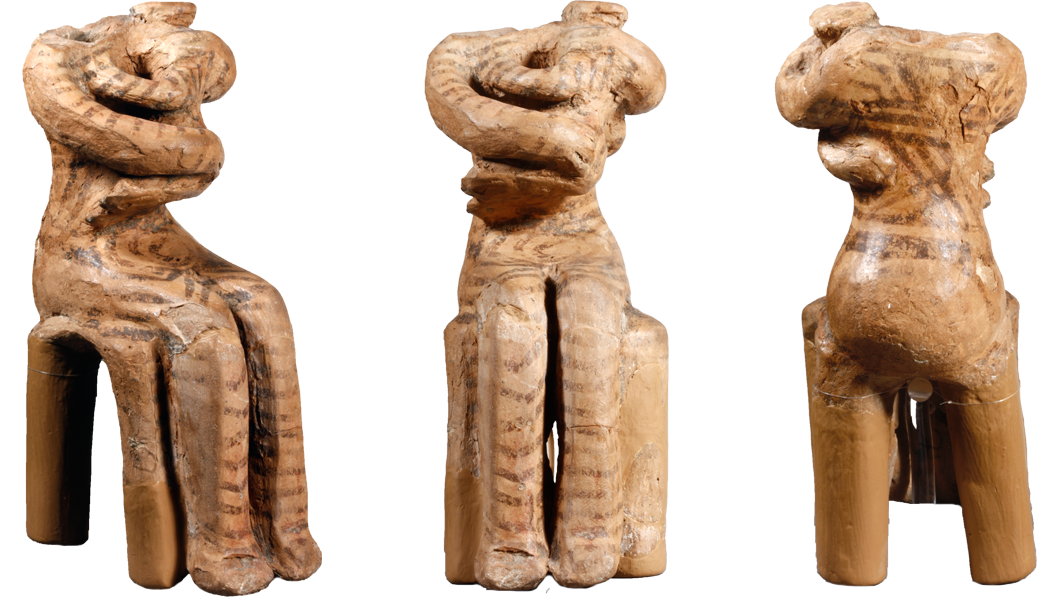Exhibit of the month
Beautiful young “lady” of the Neolithic Age …
Clay figurine of a kourotrophos
National Archaeological Museum
Collection of Prehistoric Antiquities, inv. no. Π5937
Provenance: Sesklo, Thessaly
Dimensions: Height: 16.5 cm
Date: 4800-4500 BC
Display location: Exhibition of Neolithic Antiquities, Room 5, showcase 10.
The female figure is shown seated on a stool gently holding and suckling an infant in her arms. The child partly hides its face in her mother’s bosom, whereas one of its hands rests on her right breast and the other embraces her back. The arms of the nursing mother encircle the child’s body fixing it to a breastfeeding position. The clay craftsman captured with artistic acumen the primordial moment in a woman’s life when she feeds the child from her body, thereby assuming the role which later nature is about to play, a role associated with divinity. The spiral arrangement of the arms in the tender embrace between the mother and the infant reflects the act of breastfeeding. The image remains undisturbed despite the absence of the added head of the mother.
The entire surface of the figurine bears painted decoration composed of brown bands, with the exception of the abdomen and the buttocks of the mother and the child, which are occupied by a spiral motif. The repetition of the spiral on the body of the two figures establishes a connection between them, possibly indicating their same gender, and their relation, that they are in fact mother and daughter.
Both figures are richly decorated, resembling the clay vases of the period. The motifs possibly reflect creations of weaving. The garment, at least the mother’s, was possibly gauzy, since the outline of her legs is visible, as though she wears trousers. Its fabric consists of parallel bands intersecting crosswise on the back. Is it possible that the bands were made by weaving yarn of different colour or were they autonomously attached bands? In any case, the spiral motif could also be woven (or knitted) in the Neolithic Age. However, the fact that the bands extend over the legs of the seat weakens the argument that the figure was wearing trousers. Finally, while the fingers on the mother’s hands are indicated by incisions, her feet are covered with bands (possibly denoting shoes?).
The group of the mother and child differs from the female figures of the earlier Neolithic periods, which are usually depicted seated on the ground, corpulent and nude, sometimes bearing tattoos and elaborate hairstyle . The figurine is indeed unique. The straight body of the seated figure is shapely and youthful, filled with decoration, similar to the child’s figure. The relatively large size, adding the missing head, turns the figurine visible among a large group of people, whereas the traces of red paint added to the legs and arms attest to its ritual use.
The theme of the mother and child is seldom in the Neolithic iconography, not just in Greece, but also the Balkans and Asia Minor. Even in the important settlements of Catal-Hoyuk (7500-5700 BC) and Hacilar (5600-4500 BC) in south-western Turkey it is rarely encountered. Most importantly, the specific position in which the infant is embraced and supported during breastfeeding does not find exact parallels. It appears that even then every mother, either mortal or immortal, carried her child in her own unique manner.
Dr Katia Manteli
Bibliography:
Bailey, D., Prehistoric Figurines: Representation and corporeality in the Neolithic., London, 2005.
Biehl, P. F., “Children in the anthropomorphic imagery of the European and Near Eastern Neolithic”, in T. Guner Coskunsu (ed.) The Archaeology of Childhood. Interdisciplinary Perspectives on an Archaeological Enigma, State University of New York Press, 2015, pp. 189-216:198.
Hodder, I., “Women and Men at Catal-Hoyuk” Scientific American, 2004 (January), pp. 76-83.
Nanoglou, S. “Subjectivity and material culture in Thessaly, Greece: the case of Neolithic anthropomorphic imagery”, Cambridge Archaeological Journal, 2005, 15 (2), pp. 141-156.
Sarri, Kalliope (forthcoming). Research project of experimental archaeology 2015-2017 on weaving technology, the motifs (spiral) and the raw materials of fabrics in the Greek Neolithic culture. Study of 500 spindle whorls and weaving equipment from Sesklo and Dimini in the National Archaeological Museum. Dr Calliope Sarri expressed the argument on the use of trousers by women in Neolithic Thessaly (Centre for Textile Research, University of Copenhagen, website: ctr.hum.ku.dk).
Τσούντας, Χρ., Αι προϊστορικαί ακροπόλεις Διμηνίου και Σέσκλου. Athens, 1908, p. 290, pl. 31: 2.
Χουρμουζιάδης, Γ. Χ., Τα νεολιθικά ειδώλια. Thessaloniki, 1994.


